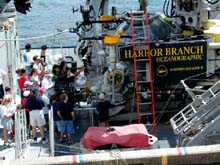
Submersible pilot Don Liberatore shows students the collection equipment on front of the Johnson-Sea-Link submersible. Click image for a larger view.
Leg 3 Begins, & The Journey Continues
August 18, 2002
Paula Keener-ChavisNational Education Coordinator
NOAA Office of Ocean Exploration The sea is as near as we come to another world. -- Anne Stevenson, American Poet
The much-needed rain did not stop over 300 students and their teachers from touring the NOAA Ship Ron Brown and the Harbor Branch Oceanographic Institution's (HBOI) research vessel Seward Johnson during a special Ocean Exploration Port Day held yesterday in Charleston, South Carolina. The teachers recently participated in a program designed to engage their students in lessons that are tied to the exploration and research taking place as part of the Islands in the Stream 2002 Expedition. Scientists and vessel crew spent the better part of the day talking with the visitors about spawning aggregations of fishes and other discoveries made during Legs 1 and 2 of the Expedition, as well as biomedical compounds from the sea, visual ecology of benthic animals, and bioluminescence to be explored during Leg 3. Teachers and students also got to see the Johnson-Sea-Link II, a four-person submersible that will take scientists over the next two weeks to little-known and previously-unexplored areas in the South Atlantic Bight.
As theSeward Johnson departed Charleston earlier this morning, it did not take long for the seas to change from the murky-brown color so characteristic of coastal waters off the South Carolina coast to the deep, shimmering blue of the Gulf Stream, complete with mats of floating Sargassum, a brown algae that forms a unique habitat for many open-ocean inhabitants.
Itís 12:30 p.m. and the Chief Scientist Dr. Shirley Pomponi, assembles the principal investigators and submersible pilots in the galley for a preliminary overview of the mission plan. As they sit around a small table, a well-marked and well-used chart of the South Atlantic Bight from Cape Hatteras to the Straits of Florida is spread out, along with a few scientific papers, one published as early as 1962, as the scientists review what is known-and what is not known-about the region soon to be explored.
John Reed, Edie Widder, and Tammy Frank, join Pomponi in reviewing historical data from the region. Reconnaissance from GLORIA side scan sonar, Loran A positions, and limited submersible dives have revealed a series of pinnacles, or vertical protrusions from the ocean floor, and ridges located in fours areas that will be extensively explored over the next two weeks. The deep-water coral, Oculina, grows atop these pinnacles and ridges, which according to Mr. Reed, are some of the most biologically-diverse areas known to exist in the deep sea.
Four sites are selected for exploration. The first is referred to as the "Stetson Site," located at the east edge of the Blake Plateau and first described in 1962 by Stetson as "an area of as many as 200 pinnacles up to 500 feet tall" previously unexplored by submersibles. "No one has ever seen this site before," says Reed. "It's total exploration." The second site is the western edge of the Blake Plateau on an area known as the "Charleston Lumps" in approximately 500-700 feet of water. This area is reported to have many ledges with lots of attached invertebrate growth and low pinnacles. A series of Lophelia reefs located in much deeper water, 1,600-2,000 feet, characterizes the third site located off Savannah, Georgia. The fourth site, located off Jacksonville, Florida, is reported to have spectacular pinnacle structures in water as deep as 3,000 feet. Although this site is reported to be rich with coral growth, it has primarily been the focus of geological investigations.
The scientists continue conversations about gear deployment and retrieval, sample collections, and submersible dive logistics as they plan their explorations for compounds from the sea for use in pharmaceutical research, deep-sea corals, and vision and bioluminescence in the deep sea. Baited traps, the "Eye-in-the-Sea" camera, pinger frequencies, current velocities, soak times, expected battery life, neuston net and Tucker trawls tows, and SCUBA dives are topics of discussion. Additionally, a preliminary dive plan is developed prior to arriving at the first site later tonight.
Back in the dry lab, Tammy Frank and her graduate student, Nicole McMullen, devise a "dark room" out of black plastic that is taped from ceiling to floor to conceal the light from her experiments on color vision in deep sea shrimp and crabs. John Reed plots coordinates for the four selected dive sites, and Eric Warrant of the University of Lund, Sweden, works on an outline of a book, entitled Invertebrate Vision. Preparations for exploration, coupled with great anticipation for what discoveries lie ahead, are well underway at sea tonight.
References:
Stetson, T.R., D.F. Squires, and R.M. Platt. 19962. Coral Banks Occurring in Deep Water on the Blake Plateau. Amer. Mus. Nov., No. 2114:1-39.
Sign up for the Ocean Explorer E-mail Update List.














































